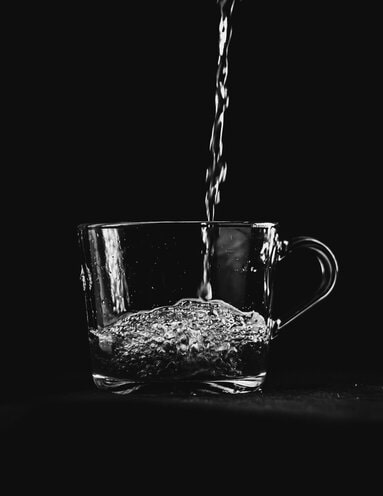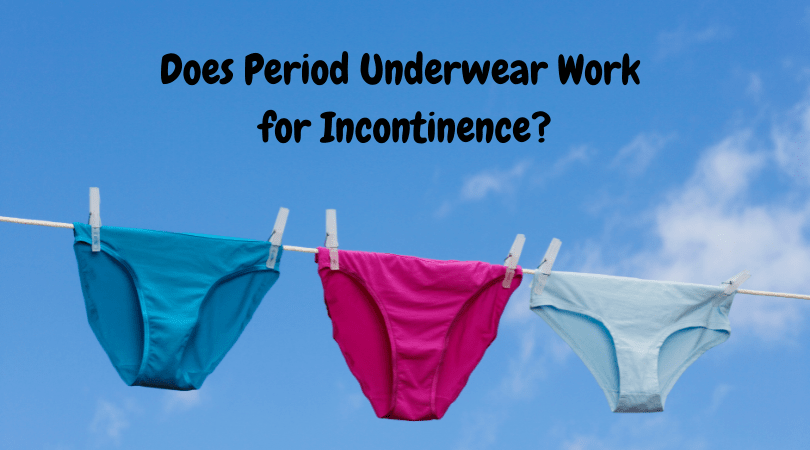The short answer? Maybe.
I know, I know. “Maybe” doesn’t tell you anything.
Some of my customers use my products for periods, as well as for incontinence. Until recently, I hadn’t thought too much about mass produced period underwear that is marketed both for periods and light bladder leaks.
Sorry any-guys-reading-this-article, but I promise that I’m done mentioning periods (well, now I am) and there’s lots of really great relevant info coming up that has nothing to do with the, uh, aforementioned thing.
But back to the question.
Can they work for incontinence?
The Thinx brand has a seperate line called Speax that is specifically for light bladder leaks (LBL) and can hold up to 8 teaspoons of liquid, while their typical period underwear holds 5-9 teaspoons, depending on absorbency.
But what does that even mean!?
I got a kick out of watching their product video where they demonstrate that the underwear really can absorb 8 teaspoons of liquid. READ: I took issue with it.
Here’s why:
1. They Disregard the Flood Zone
Thinx really mastered the art of creating a beautiful video to showcase the absorbing properties of their underwear. So much so that you get all caught up in the Zen background and the lovely music so you don’t notice the glaring flaw in the demonstration.
They gracefully poured the water UP AND DOWN the crotch area.
Let’s be real. When you have some leakage down there, it’s not like you’re going to be moving the crotch of your underwear up and down to evenly distribute said leakage along the absorbing liner. Instead, the bulk of the output is going to hit ONE spot.
Enter the flood zone.
The flood zone is the area where the liquid hits the fabric. This is NOT the whole crotch area.
For example, when you experience a little bladder leakage, it’s going to land more to the front of the item. If this area can’t absorb the quantity of liquid it needs to absorb, then you will have leaks.
Basically what happens is that the moisture hits the absorbing layer in one area. Then, as the layer absorbs, the moisture eventually gets wicked further along the absorbing layer.
For example, when I would cloth diaper my kids, I would notice that the front half of their pocket diaper inserts would be completely saturated and start leaking at the legs even though the back part of the inserts were barely damp.
If too much moisture gets concentrated in one area of the absorption layer, well, hello leaks!
In addition, something that never seems to make it to consideration on these things is the rate that the liquid comes out. If your bladder is like a leaky faucet, then congratulations, you probably rarely have to deal with undergarment leaks. (If you do, see point #2).
If it’s more like sneeze/cough = small waterfall, then you’re in a whole different ball game.
Basically, instead of Thinx’s graceful demonstration, they should have just dumped the whole beaker of water straight onto the front portion of the crotch. Just dumped it.

I’ll just hazard a guess that that would not make for a very successful demo for them.
Anyway.
If you think about it, it’s actually all a bit sciency!!!
Force of dispellation + quantity of liquid = absorbing needs
Conquer that and you will conquer leaks.
Well, except for #2.
2. Uh, how long is the liquid staying down there?
This question ALWAYS gets overlooked.
I usually get asked how much my products hold, but this is not the right question to ask….
There was one particular instance in my 6 year tenure as incontinence product creator where someone specifically asked for an item to hold liquid for a particular amount of time.
Aka, ALL DAY.
Despite my attempt to point out that it was not realistic, the person paid me a large amount of money to try. An attempt that was a failure (for reasons we are about to discuss), which led me to giving them a large refund, was a general waste of time and money for everyone involved, and made me feel feelings that I don’t like to feel in my business.
But WHY did it fail?
After all, I used multiple layers of hemp and 3D zorb, (the most I’ve ever used) plus an additional insert and a 10 inch crotch width. Although it was an All-in-One diaper style, which I would never recommend for overnight or all day if you’re dealing with severe incontinence.
The above equation is sufficient if you plan to change very soon afterwards. If you can’t (you’re in public) or don’t want to (too much hassle) then we have to add another variable.
Force of dispellation + quantity of liquid+ duration of time held = absorbing needs
When taken in the context of fabric moving moisture from your body and putting it into other fabric so you feel nice and dry, wicking is your friend.
But in the context of moving moisture from the absorbing fabric onto your clothes, wicking is your enemy.
This particular type of wicking happens when the product you’re wearing is wet for a while and has no moisture barrier (so that wet fabric is touching your clothes) or if there’s any gaping between the product and your body.
And FYI? PUL IS waterproof. After the above debacle, I emailed Wazoodle Fabrics to get the down low on PUL waterproofness and why it might have felt like it was leaking to my customer.
Their answer? If PUL feels wet on the outside, it’s because moisture has leaked from the leg or waist opening and migrated across the PUL, making it feel wet.
Which makes sense, because PUL is a polyester knit fabric that has been laminated on the back side. Polyester itself is not waterproof, and though it absorbs minimal moisture, the fibers can still feel damp.
Let’s face it, cloth isn’t plastic and the part on the leg where the liner and the outer are sewn together and have a seam, moisture will EVENTUALLY leak from the liner onto the PUL and migrate.
Moral of the story:
If you have enough absorption to catch where you need it to catch plus a waterproof barrier – in the form of the appropriate product type, I may add – you’re good.
For a little while.
Then eventually that moisture will seep out along the seam or gap and transfer to your clothes.
How long a particular product will give you before the enemy wicking comes to destroy your peace of mind, would just be a matter of trial and error.
The only possible exception to this rule would be if you were using actual plastic pants. Because they’re plastic, they are completely waterproof. Like, there will be no migrating of moisture or wicking as long as you have a good fit and there is no fold over elastic around the leg openings.
But plastic pants come with a price, that depending on your situation may or may not make it worth it.
In the end, a good quality product with appropriate absorption will not leak right away. The key here is choosing the right type of product with the right amount of absorption for your particular needs.
Definitions of Incontinence
But wait!
Exactly how much is 8 teaspoons in incontinence lingo!?
Well, my friends, you’re in luck!! A study published in 2011 endeavoured to answer this question.
Here are the definitions of incontinence according to a 24 hour pad test:
Mild: 1.31 mL – 20.21 mL or 2 teaspoons – 4.1 teaspoons
Moderate: 21.22 mL – 74.78 mL or 4.3 teaspoons – 15.17 teaspoons
Severe: greater than 75.78 mL or 15.37 teaspoons
But what does this even mean?!
Does this mean that if you have mild incontinence, you can use a single pair of period underwear all day and have complete protection?
Does it mean that if you have moderate incontinence, you can get away with going through several pairs of period underwear throughout the day?
As we have discussed throughout this post, it’s really not that simple. But if you take into account force of dispellation (how fast the pee comes out) + quantity of liquid + duration of time held = absorption needs, you can reasonably assume whether a given product will work for you or not.

The Takeaway
The amount of liquid a product claims to hold is not a completely accurate indicator that the product will work as you need it to.
You must also take into account the type of incontinence you have, plus how often you will be able to change.
As for period panties, if your bladder is a leaky faucet, then they can be a great way to help you manage that pesky inconvenience.
Hmm…incontinence and inconvenience share many of the same letters…
But if that pesky inconvenience has a bit more substance to it, period panties may not be the best option for you unless you’re planning to change right away. Luckily, there are plenty of cloth products out there that don’t infringe on the dreaded “diaper” territory and can give you some peace of mind and confidence in your body.
Again, when determining whether a product – or what product – will work for you, you need to take into account several variables. At the end of the day, a little trial and error is necessary in order to cultivate the exact system that will work for your unique needs.
Alecia
Latest posts by Alecia (see all)
- Best Adult Diaper Covers - March 7, 2024
- Best Fabrics for Making Adult Diaper Covers - February 16, 2024
- How to Use the Zigzag Stitch - May 4, 2023


